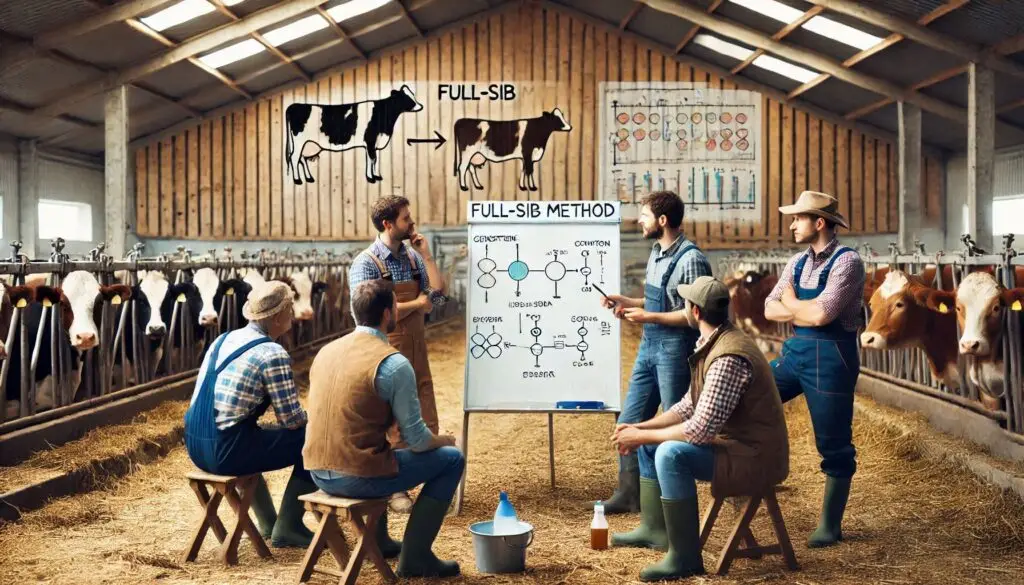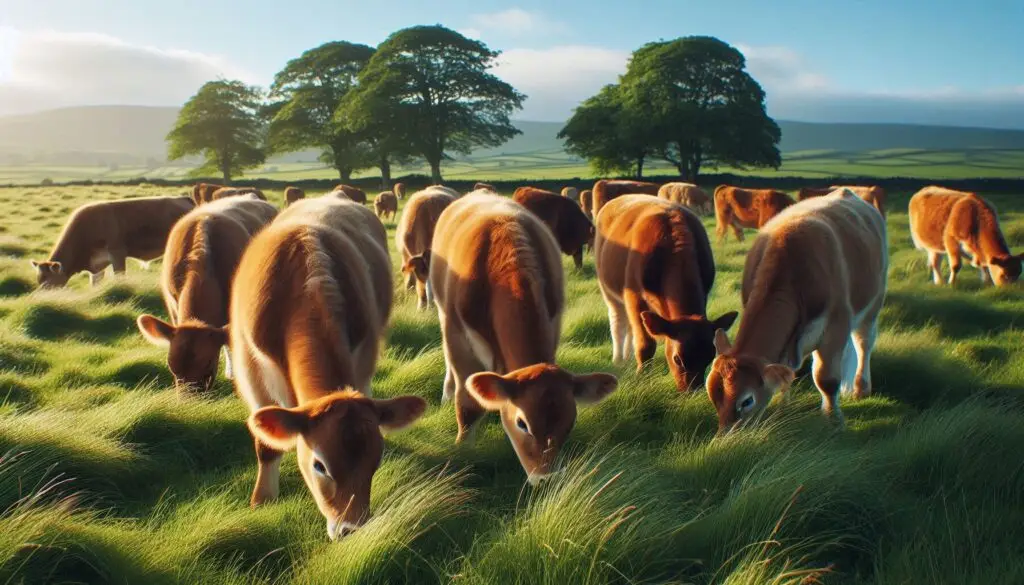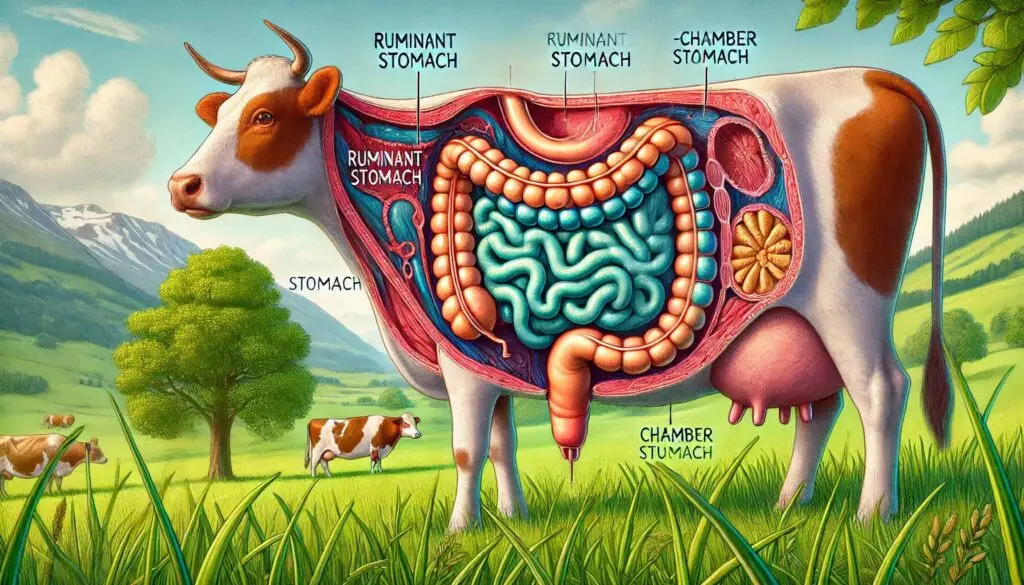Bloat in Ruminants

What is Bloat in Ruminants?
Bloat is a common and often serious condition in ruminants such as cattle, sheep, and goats. It occurs when there is an excessive build-up of gas in the rumen, the first compartment of the stomach. This build-up leads to severe abdominal distension, discomfort, and can even be fatal if left untreated. Understanding the different types of bloat and their symptoms is crucial for preventing and managing this condition.
The two main types of bloat are Primary Bloat (Frothy Bloat) and Secondary Bloat (Free Gas Bloat), each caused by different factors.
Types of Bloat in Ruminants
Primary Bloat (Frothy Bloat)
Primary bloat, also known as frothy bloat, occurs when gas accumulates in the rumen in the form of foam or froth. This foam traps the gas, preventing it from being released during normal fermentation. The primary cause of this condition is the consumption of large quantities of certain leguminous plants, especially clover and alfalfa, which contain high levels of fermentable carbohydrates.
When animals graze on lush, young clover or alfalfa, the fermentation process produces gases that become trapped in the froth. The foam can’t escape, leading to distention of the rumen and discomfort. Farmers and veterinarians need to be vigilant about these plants’ availability during specific grazing periods.
You can learn more about this condition from reputable sources like Veterinary Partner for in-depth research on managing primary bloat.
Secondary Bloat (Free Gas Bloat)
Secondary bloat, often referred to as free gas bloat, occurs when there is a physical obstruction in the digestive tract. This blockage prevents the normal release of gas during fermentation, leading to its accumulation in the rumen. Causes of secondary bloat include conditions like esophageal obstruction, vagus indigestion, diaphragmatic hernia, and ascites.
In contrast to primary bloat, secondary bloat doesn’t involve the formation of froth. Instead, it is more about the difficulty of releasing trapped gas. This type of bloat is typically easier to diagnose, as it often presents with more distinct clinical signs, such as difficulty in swallowing and coughing.
For a better understanding of secondary bloat, consult the Cornell University College of Veterinary Medicine which offers detailed case studies on similar veterinary conditions.
Diagnosis of Bloat in Ruminants
Recognizing the symptoms of bloat is crucial for early intervention. A common diagnostic sign of bloat in ruminants is a distended abdomen, particularly on the left side. The affected animals may also appear distressed, pawing at the ground or frequently shifting between standing and lying down.
Key Symptoms of Bloat
- Abdominal Distention: The animal’s abdomen, especially the left flank, may appear noticeably swollen and tense.
- Champing and Teeth Grinding: Animals often grind their teeth in discomfort.
- Tympanic Sound: On percussion of the left flank, a hollow, drum-like sound (tympany) is heard, indicating the presence of gas.
- Difficulty Breathing and Salivation: The animal may have labored breathing, protruding tongue, and excessive salivation.
- Behavioral Changes: Animals with bloat may kick their belly, roll on the ground, or stand frequently in an attempt to alleviate discomfort.
It is important to distinguish between primary and secondary bloat, as the treatments for each can differ significantly. Veterinary diagnostic tools, including ultrasound and rumen fluid analysis, can be invaluable for identifying the exact cause of the bloat.
Treatment of Bloat in Ruminants
Effective treatment of bloat depends on the type of bloat and the severity of the symptoms. For both primary and secondary bloat, the goal is to relieve the trapped gas and prevent further complications.
Immediate First Aid for Bloat
- Withdraw Food and Water: The first step in treating bloat is to remove any available food and water from the animal to prevent further fermentation.
- Administer Charcoal: Applying activated charcoal to the tongue can help reduce the froth in the rumen.
- Elevate the Front Portion of the Body: Elevating the animal’s front end can help facilitate the release of gas.
Medical Intervention
For more severe cases, the following treatments may be necessary:
- Trocarization: This involves using a needle or trocar/cannula to puncture the rumen and allow the gas to escape. This is a common procedure for severe bloat.
- Stomach Tube: A stomach tube can be inserted into the rumen to help expel excess gas.
- Carminative Mixtures: These mixtures help break down the froth in the rumen, allowing gas to escape more easily.
- Oral Antibiotics and Antihistamines: These can be used to reduce inflammation and control any bacterial overgrowth in the rumen.
- Calcium Borogluconate: This solution helps restore the balance of electrolytes and promotes normal rumen motility.
- Use of Wilted Legumes and Dry Roughage: Offering roughage can help stimulate normal digestion and prevent further gas build-up.
In cases of secondary bloat, treating the underlying condition, such as relieving an esophageal obstruction or repairing a diaphragmatic hernia, is crucial.
Preventing Bloat in Ruminants
Prevention is key when managing bloat in ruminants. Strategies include proper grazing management, avoiding overfeeding of legumes, and ensuring animals have access to roughage. Regular monitoring of animals for early signs of bloat can help prevent more serious issues from arising.
Additionally, for those interested in more preventive measures, articles on best practices in grazing management and feeding schedules can be found on Animal Health Direct.
Conclusion: Managing Bloat in Ruminants
Bloat is a serious condition that can affect ruminants like cattle, sheep, and goats. Recognizing the symptoms early and implementing appropriate treatment measures can save lives and prevent long-term health issues. Always consult with a veterinarian if bloat is suspected, especially in severe cases.
More From Animal Diseases:
Pyridoxine deficiency in Birds





Responses